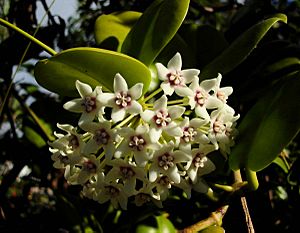Waxvine facts for kids
Quick facts for kids Waxvine |
|
|---|---|
 |
|
| Scientific classification | |
| Genus: |
Hoya
|
| Species: |
australis
|
The Hoya australis, also called the waxvine or common waxflower, is a cool plant from the Hoya family. It's a type of vine that grows in rainforest edges and on rocks. You can find it in eastern and northern Australia. It grows from Western Australia all the way through the Northern Territory and coastal Queensland. It reaches from Cape York down to northern New South Wales. Many people love to grow it in their gardens because its flowers smell amazing.
Contents
How Scientists Name Plants (Taxonomy)
Scientists give plants special names to help everyone know exactly which plant they are talking about. This is called taxonomy. The common waxflower was first described in 1828. A botanist named Robert Brown gave it its scientific name. The word australis comes from Latin. It means "southern," which makes sense because it grows in southern places.
Different Types of Hoya australis (Subspecies)
Just like there can be different types of dogs, there are also different types of Hoya australis. These are called subspecies. They are slightly different versions of the same plant.
- Hoya australis australis
- Hoya australis oramicola – This type was found in 1991. It only grows on Bathurst Island near the Northern Territory coast.
- Hoya australis rupicola – You can find this one in the Kimberley (Western Australia) area and the Northern Territory.
- Hoya australis sana
- Hoya australis sanae
- Hoya australis tenuipes
What the Waxflower Looks Like (Description)
The Hoya australis is an evergreen climbing vine. This means it stays green all year round. It can grow quite long, from about 4 to 10 meters (13 to 33 feet). Its leaves grow opposite each other on the stem. They are smooth and shiny. Each leaf is about 3–6 cm long and 2–5 cm wide.
The leaves are thick and fleshy, like a succulent plant. They are shaped like an oval or egg. Leaves that get a lot of sun are more yellowish-green. Those in shadier spots are a darker green.
This plant can flower at any time of the year. Its flowers grow in clusters, like little umbrellas. These clusters are at the end of short stems. Each flower is about 1.5–2.5 cm wide. They have five thick, waxy petals. The petals are triangular and white. Each petal has a red mark. The flowers have a very strong, sweet smell. They also make a lot of sweet liquid called nectar.
How the Waxflower Helps Nature (Ecology)
The Hoya australis is an important food source for some insects. The caterpillars of certain butterflies eat its leaves. These include the no-brand crow butterfly (Euploea alcathoe) and the common Australian crow butterfly (E. core).
The flowers are also important for other insects. They are pollinated by a butterfly called the southern grass-dart (Ocybadistes walkeri). This means the butterfly helps the plant make seeds.
Where the Waxflower Grows (Distribution and Habitat)
In Australia, you can find the Hoya australis in many places. It grows from Grafton in northern New South Wales. It goes all the way north to Cape York in north Queensland. It likes to grow on the edges of rainforests. It also grows in rocky areas that are open to the sun.
Growing Waxflowers at Home (Cultivation)
The Hoya australis is a very popular plant for gardens and homes in Australia. It grows best when it gets a lot of light. Many people grow it in pots. They train it to climb on trellises on porches, fences, or in glasshouses. It's a great plant to have in your garden if you want to attract butterflies. You can even grow it indoors if it gets direct sunlight.
See also
 In Spanish: Hoya australis para niños
In Spanish: Hoya australis para niños

